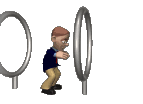How to discern a fake $2.5 Indian?
I'm hearing much to much about the commonality of counterfeit $2.5 Indians. Also that a lot of the fakes are difficult to detect. Does anyone have any insight into what the giveaways might be? Do most of them weigh out all right--are they in fact golf? Has anything been published on this topic? I'm gobsmacked by these, have collected several, and would rather be hurt early than late.

0
Comments
..........................
Herb
bad ones are usually brighter - do not have the copper or mixed as well
if you can go to a big show, ANACS will provide free opinions on coins - if they are there
I did get to see some counterfeit ones. At first glance, they look real. The size, weight, and gold content were correct. The gold was a bit too new looking (bright and yellow). There is often a bit of rub (roll friction) of the real ones. The fakes also have some tiny tooling marks or other odd raised lines. Overall, they are dangerous counterfeits.
FrederickCoinClub
I've found the easiest way to discern a fake $2.5 Indian is to see the Not Genuine sticker on bodybag when it comes back from PCGS.
My posts viewed
since 8/1/6
BTW this is the obverse of a genuine 1911-D $2.50 gold piece.
I would know- my grandfather's 1914 came back bb'd by NGC for that same reason. Sent to the ANA for authenticity and it came back counterfiet with tooling marks in the same area and above the date.
Just out of curiosity, why does the high point of the coin normally reveal the signs of counterfeiting? Would the lower parts show it as well? Thanks.
Didn't wanna get me no trade
Never want to be like papa
Working for the boss every night and day
--"Happy", by the Rolling Stones (1972)
NoEbayAuctionsForNow
roadrunner
No more raw Indians on ebay. I suspect I've fared only OK; only time and returns from PCGS will tell. In no walk of life I've encountered so far have I seen such widespread chicanery. It appears a savage hobby, but I love it so.
Two more questions before sleepy time: (1) How on earth does PCGS in their price guide place values in the thousands on certain MS70 Silver Eagle? And (2) BillJones, can I have that Indian?
<< <i>Bill:
Just out of curiosity, why does the high point of the coin normally reveal the signs of counterfeiting? Would the lower parts show it as well? Thanks. >>
Most "manufactured" (as opposed to genuine coins that have been altered) counterfeit coins are made by producing a mold or some sort of an impression from a real coin. The deeper you get into the design, the harder it is to duplicate the devices. Therefore it is hard to get it right in that area of the Indian's neck because it's the deepest part of the design. There will almost always be imperfections there, and if the counterfeiter tries to remove them, there will be tell-tale tool marks there instead.
<< <i>Two more questions before sleepy time: (1) How on earth does PCGS in their price guide place values in the thousands on certain MS70 Silver Eagle? And (2) BillJones, can I have that Indian? >>
(1) The PCGS price guide (like all price guides) is a guide not a statement of absolute fact. Many collectors feel that the amounts that are provided there are on the high side. Some would say that those high numbers are somewhat self-serving.
(2) That 1911-D Indian is still raw, and it's in a complete set that I put together in the 1980s. I would grade it an AU-55, but the services might have other ideas. At any rate the coin is real because it has all of the classic earmarks of the 1911-D issue.
Here is an example of a 1912 Indian $2.5 that I purchased raw and got taken! (Lesson learned.) Note also the weak rims.
Hoot
Isn't there a luster break in the arrow heads of the real coins? Seems this was posted here somewhere before.
Dan
First Place Winner of the 2005 Rampage design contest!
Dan
First Place Winner of the 2005 Rampage design contest!
"La Vostra Nonna Ha Faccia Del Fungo"
bob
Linky
- Marcus Tullius Cicero, 106-43 BC
Worry is the interest you pay on a debt you may not owe.
"Paper money eventually returns to its intrinsic value---zero."----Voltaire
"Everything you say should be true, but not everything true should be said."----Voltaire
Meanwhile, the lab where I was working had , of course, all kinds of equiptment around. Microscopes with Polaroid cameras attached, for one thing. I had, just by chance, photographed these coins before selling them. Two of them just happen to be the same date. I compared the pictures one afternoon and........wait a minute....."These coins are IDENTICAL !!".
I fly over to dealer number 1 and show him the pictures. He gets all defensive and pulls 2 more two-and-a-halfs out of the case and puts them into the vault. Meanwhile, I'm livid......I go back to shop number 2, with my tail between my legs, ready to take my lumps. I confess that the coins have been fake. Dealer number 2 admits selling them already to non-regulars. He admits he may never see these people again and tells me not to worry about it. Whew......
These things can certainly be deceiving as I learned first hand.